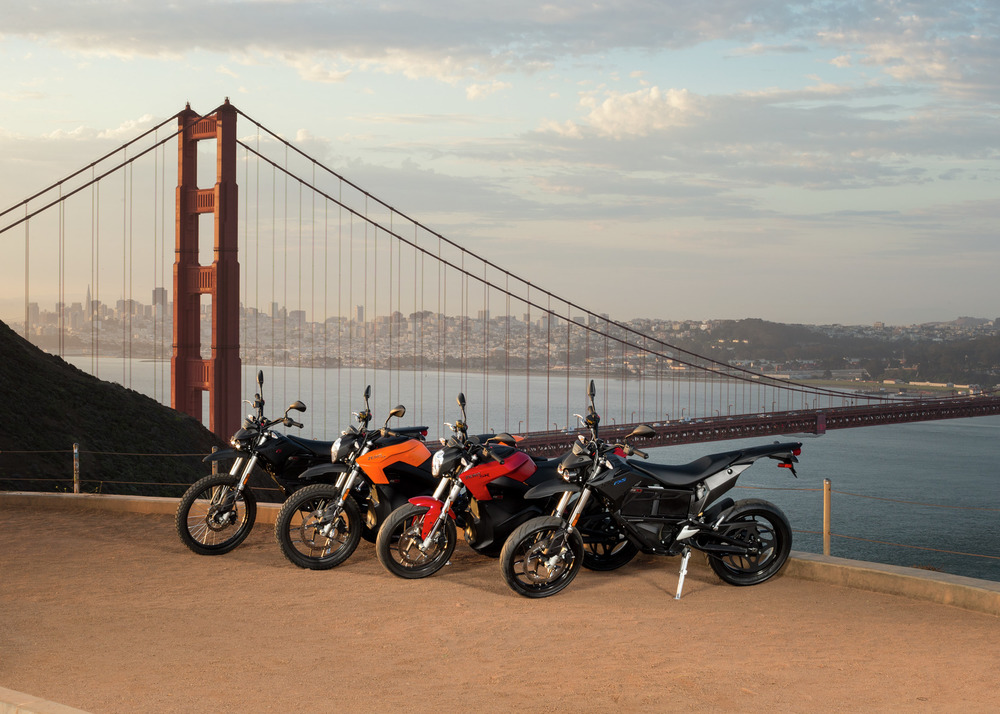The Zero Motorcycles 2016 lineup features an iterative improvement over previous model years, plus the addition of a few new models. The improvements include up to 197 miles (city) riding range (131 miles combined), increased top speed and power.
Zero S: The company’s street bike which serves as the base of several other models. The Z-Force 75-7 motor, and 420 amp controller, produces up to 54 horsepower, a 0-60 miles/hr time of 5.8 seconds, a 95 miles/hr top speed and sustained 85 miles/hr top speed.
The energy storage is 9.8 kiloWatt-hours for 81 miles combined range, 13 kiloWatt-hours for 108 miles combined range, and the optional power tank bumps it to 131 miles combined range.
Pricing: ZF9.8 $10,995, ZF13.0 $13,995, Power tank $2,674, Charge Tank $1,988
Zero SR: The ‘R’ models have a beefed up power train that’s intended for racing. The Z-Force 75-7R motor, coupled with a 660 amps controller, increases power to 67 horsepower, 0-60 miles/hr time of 3.3 seconds, a 102 miles/hr top speed, and sustained 95 miles/hr top speed.
The SR does not come in a 9.8 kiloWatt-hour version.
Pricing: ZF13.0 $15,995, Power tank $2,674, Charge Tank $1,988
Zero DS: This takes the Zero S, changing the suspension and other components to make a Dual Sport bike that’s comfortable on-road or off-road. This model shares power train with the Zero S, for the same power and top speed but a slightly slower 0-60 miles/hr time.
The energy storage is 9.8 kiloWatt-hours for 71 miles combined range, 13 kiloWatt-hours for 95 miles combined range, and the optional power tank bumps it to 116 miles combined range.
Pricing: ZF9.8 $10,995, ZF13.0 $13,995, Power tank $2,674, Charge Tank $1,988
Zero DSR: Like the SR, this is the Zero DS but with the 75-7R drive train. The Zero DSR is new in the 2016 model line. That gives it the same power as the Zero SR, but a slightly slower top speed of 98 miles/hr or 90 miles/hr sustained. The 0-60 miles/hr time is also a little slower.
Pricing: ZF13.0 $15,995, Power tank $2,674, Charge Tank $1,988
Zero FX: This is Zero’s lightweight “streetfighter” bike, and unlike the previous models it is not based on the Zero S. Part of what makes this bike lighter weight is that the battery pack is two removable modules at a lower energy capacity. The FX ZF3.3 has 3.3 kiloWatt-hours capacity giving 24 miles combined range, while the ZF6.5 contains two packs for 6.5 kWh energy storage and 49 miles combined range.
It also has a different motor, the Z-Force 75-5, coupled with a 420 amp controller, for 44 horsepower, 85 miles/hr top speed, 70 miles/hr sustained speed, and 4 seconds 0-60 miles/hr time.
Zero FXS: This is billed as a Supermoto version of the FX, and is also new for the 2016 model line. It has the same 75-5 motor and 420 amp controller offering up to 44 horsepower, 82 miles/hr top speed, or 75 miles/hr sustained. The ZF3.3 gives 26 miles combined range and ZF6.5 gives 52 miles combined range.
Zero FXP, Zero DSP, Zero SP: Are police-ified versions of some of the above bikes.
Zero MMX: Military version of the FX.
Charge tank: This is a new accessory to the Zero S/SR/DS/DSR line. One can install either the Power Tank or the Charge Tank. The power tank adds additional energy capacity, but the bike is still saddled with a paltry 1.3 kiloWatt charge rate and does not support J1772 charging. The Charge Tank instead adds a J1772 charging port, and bumps it to a 3.3 kiloWatt charging rate. That then drops charging time from 10+ hours down to about 2-3 hours.
A 3rd party Charge Tank product was just announced by DigiNow/eMotorWerks, see my writeup elsewhere![]() . The DigiNow charge tank also offers a J1772 port and bumps the charging rate as high as 9-10 kiloWatts, making for a 1 hour recharge time.
. The DigiNow charge tank also offers a J1772 port and bumps the charging rate as high as 9-10 kiloWatts, making for a 1 hour recharge time.







